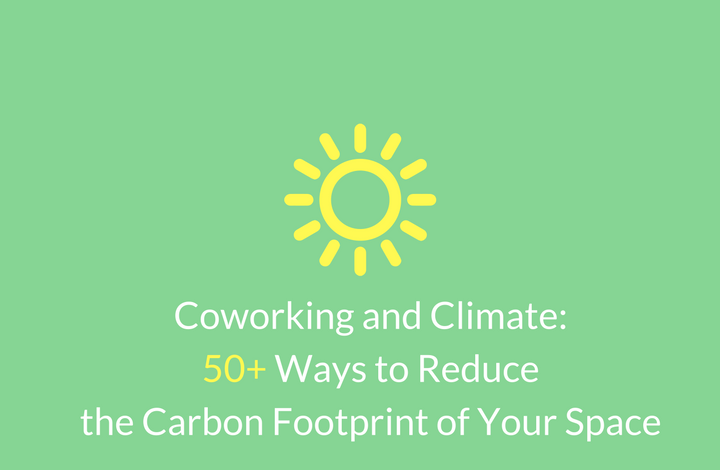Concerned about climate change? Me too.
The powers-that-be may dismiss the urgency of climate issues so we need to take things into our own hands.
There are are many, many things we can do to reduce our own carbon footprints, at home and in our coworking spaces, with or without the help of government.
Here are 50+ ways to address climate change in your coworking space. Choose which ones work for you, do as many as you can, and, if you have any ideas to add, please do so in the comments. The more strategies we have, the better.
1. Evaluate your current carbon consumption. Find a local expert to help you get your baseline. Making improvements becomes much easier when you know where you’re starting from. Plus, you’ll get to see how all the quick wins add up to big improvements.
2. Create a culture of clean and green. With your signage, event planning, communications and general culture, prioritize sustainability, mindfulness of consumption, and resource reduction.
3. Educate your community about waste reduction and the importance of aiming for zero waste.
4. Use natural light whenever possible. When not possible, replace regular incandescent light bulbs with compact fluorescent light bulbs, which use 60% less energy than a regular bulb.
5. Turn off lights when not in use. No need to light that conference room or phone booth all day if it’s empty.
Photo: Ashes Sitoula (CC-0)
6. Install a programmable thermostat to automatically lower the heat or air conditioning at night and raise them in the morning.
7. Go solar. Solar panels require an upfront investment, but you may be able to eliminate your electric bill or even sell electricity back to the grid.
8. Be water wise. You can lower the amount of energy used to pump, treat, and heat water by using it wisely, not letting it run unnecessarily, and fixing any leaks or drips.
9. Reuse as much as possible. If you don’t need to buy something new, don’t. Get creative, be resourceful, tap into the innovative spirit of your community to repurpose and reuse items that would otherwise get thrown away.
10. Move your thermostat down a couple of degrees in winter and up a couple of degrees in summer.
11. Buy in bulk, when possible: handsoap, lotion, dishsoap, paper goods. etc.
12. Buy recycled and recyclable goods.
13. Think local. Supporting local coffee roasters, food vendors, beer brewers and other small businesses is not only good for the local economy, it’s good for the planet. Less transit time means less CO2 emissions.
14. Go organic. When shopping for your next happy hour, member lunch, event or open house purchase organic food and beverages, where possible. In addition to serving up the highest quality food, you can reduce the carbon footprint of your event and avoid icky pesticides in your food.
15. Steer clear of disposable plates, utensils, cups, etc. Stock your space with the things people need, then train the community to wash and reuse them rather than buying and throwing away disposable goods.
16. Ditch those “disposable” coffee pods. The waste generated from those little pods is crazy…and unnecessary.
17. Support local clean energy initiatives. Leverage the power of your community to amplify local projects working on issues around sustainability, repair, reuse, zero waste and clean energy.
18. Clean or replace filters on your furnace and air conditioner.
19. When purchasing new appliances, choose energy efficient models.
20. Don’t leave electronics in standby mode. Turn displays, TVs, computers etc. off when not is use. Electronics use up to 40% of their energy in standby mode.
Photo: Gustavo Quepón (CC-0)
21. Wrap your water heater in an insulation blanket to keep the heat in. Easy peasy.
22. Get an energy audit to see where you’re wasting electricity and how you can make improvements.
23. Only run the dishwasher when it’s full. If there are just a few dishes, wash them by hand.
24. Purchase products with as little packaging as possible.
25. Make recycling easy. Place bins all around the coworking space and clearly mark which ones are for recycling and which are for trash. Some people put tiny garbage bins next to regular size recycling bins to remind people that far more should go into the recycling bin than the trash bin—that throwing something away is a last resort.
26. Recycle everything possible: paper, plastic, glass, tin cans, aluminum cans, cardboard etc. You do have recycling in your space, right? Is the community recycling everything it possibly can? If not, it might be time for a reminder.
Photo: Markus Spiske (CC-0)
27. Embrace composting. Approximately 3% of the greenhouse gas emissions through the methane is released by decomposing bio-degradable waste. Look into composting food scraps and coffee grounds in your space. You may have a member that can help get a compost set up, community members who may want nice, fresh soil, or a community compost program in your town if you’d rather not deal with the food scraps yourself.
28. Encourage people to bring their own mug and water bottle rather than disposable coffee and drinking cups.
29. Switch to clean power, where possible. More and more cities have options to buy clean power. If you’re fortunate enough to have a local, clean power option near you, make the switch.
30. Reduce your meat and dairy intake. One of the biggest contributors to greenhouse gases is methane released from cows. It sounds far-fetched, but it’s true. So, cutting back on how much meat and dairy you eat — even a little at a time, can go a long way toward cutting back on harmful gases.
31. Grow your own. Do you have space for a garden? Is there interest among your members in having a community garden? Go for it! There’s nothing better than homegrown tomatoes.
32. Use drought-tolerant and native plants in your landscaping.
Photo: Aidan Meyer (CC-0)
33. Print less. Go paperless whenever possible.
34. Use refillable ink cartridges.
35. Use cloth towels rather than paper towels. If you don’t want to deal with washing them, hire a local service.
36. Use unbleached, recycled toilet paper.
37. Use natural cleaning products.
38. Donate old computers, gadgets and electronics to be refurbished and reused rather than sent to the landfill or even recycled.
39. Encourage sharing. Whether books, food, electronics, umbrellas…whatever, a spirit of sharing goes a long way in building community and cutting down waste.
40. Carpool or take public transit to your coworking space, when possible, and encourage members to do the same.
Photo: Pascal Frei (CC-0)
41. People Power. Use people-powered transportation (walk, bike, skate, pogo stick) to get to your coworking space and encourage members to do the same.
42. Provide safe and easy bike parking or storage for those who ride to your coworking space.
43. Provide a shower for those commuters who ride, run or pogo stick to the space.
44. Partner with a local carsharing or ridesharing service to get members a discount.
45. Unplug chargers when not in use.
46. Reduce airtime. Flying is one of the biggest contributors of CO2. Avoid flying, when possible, and make the most efficient use of trips when unavoidable.
47. Support local efforts in: conservation, zero-waste, recycling, clean energy, etc. How can you help your local organizations? Providing a couple hours of meeting space? Inviting them to talk to your community? Helping spread the word about initiatives? Help out where you can.
48. Go green with your new space. If a remodel, expansion or move is in your future, take the extra step of making the new space as clean and green as possible. From eco floors to natural light, solar panels, eco-friendly paint, energy efficient windows, etc. there are tons of ways to improve your space.
49. Stay diligent and curious. Where can you continue to make improvements? How can you be more energy efficient? Stay open to good ideas, new partnerships, fresh perspectives and approaches to reducing the carbon footprint of your space.
50. Put your vote where your consciousness is. Be sure to vote for officials at the local, county, state and federal level who support clean energy and a sustainable future.
51. Measure your progress. Starting with your baseline numbers, regularly measure your progress to see how far you’ve come and what impact your commitment to reducing the carbon footprint of your coworking space has.
Your turn: What have I missed? What are you doing to reduce the carbon footprint of your coworking space? In the comments let me know.
Related Posts
What Makes a Great Coworking Space? [infographic]
How to Change the Toilet Paper: a Guide for Coworking Spaces
We Need Each Other











